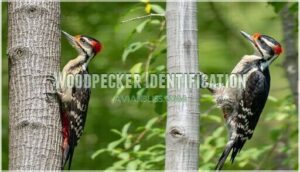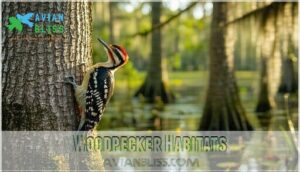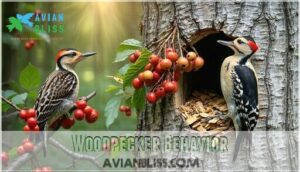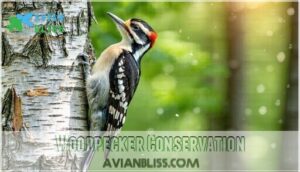This site is supported by our readers. We may earn a commission, at no cost to you, if you purchase through links.
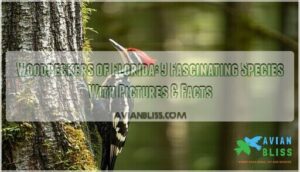
The Red-bellied Woodpecker, with its zebra-striped back, is a common sight, while the Pileated Woodpecker—Florida’s largest—commands attention with its fiery crest.
Rare species like the Red-cockaded Woodpecker are found in old-growth pine forests, relying on conservation efforts to thrive.
You’ll often hear their drumming or spot them foraging for insects, sap, or berries.
Whether they’re nesting in tree cavities or hopping up trunks, these birds are essential to Florida’s ecosystems.
Stay curious—there’s more to these drummers than meets the eye!
Table Of Contents
- Key Takeaways
- Woodpecker Species Overview
- Woodpecker Identification
- Woodpecker Habitats
- Woodpecker Behavior
- Woodpecker Conservation
- Frequently Asked Questions (FAQs)
- What is the most common woodpecker in Florida?
- What bird looks like a woodpecker but isn t?
- Is it good to have woodpeckers in your yard?
- What is the difference between a red-headed woodpecker and a pileated woodpecker?
- How many woodpeckers are in Florida?
- Are there drumming woodpeckers in Florida?
- Are hairy woodpeckers common in Florida?
- Can you spot woodpeckers in Florida?
- Are there red-headed woodpeckers in Florida?
- What is the biggest woodpecker in Florida?
- Conclusion
Key Takeaways
- You’ll find nine woodpecker species in Florida, including common ones like the Red-bellied and rare ones like the endangered Red-cockaded Woodpecker.
- Woodpeckers are crucial for ecosystems, controlling insect populations and creating cavity nests other species rely on for shelter.
- Each species has distinct habitats and preferences, from pine forests and wetlands to suburban backyards, showcasing their adaptability.
- Conservation efforts like sustainable forestry and habitat preservation are vital to protect endangered species and maintain biodiversity.
Woodpecker Species Overview
Florida hosts a remarkable variety of woodpeckers, with species adapted to diverse habitats like pine forests, swamps, and urban areas.
From year-round residents to seasonal visitors, each species brings unique behaviors, sizes, and ecological roles.
Resident Woodpecker Species
Florida woodpecker species include eight fascinating resident woodpecker species, each with unique traits.
From the Redheaded Woodpecker’s vibrant plumage to the Downy Woodpecker’s small size, these birds thrive year-round.
They showcase diverse feather patterns, drumming behavior, and diets of insects, seeds, and fruits.
Known for their cavity nesting habits and specialized beak structures, resident woodpecker species enliven Florida’s forests and backyards.
Seasonal Woodpecker Species
Some woodpeckers of Florida are seasonal visitors, adding to the state’s feathered diversity during specific periods.
Species like the Yellow-bellied Sapsucker follow unique migration patterns, arriving as winter visitors.
These migratory species often shift their ranges, influenced by breeding seasons and food availability.
Observing their flight behaviors and seasonal rhythms offers insight into how woodpecker species adapt to Florida’s environments.
Migratory Patterns
Not all woodpeckers of Florida stay put year-round. Some species follow specific migratory patterns tied to their seasonal needs.
You’ll notice these movements during migration routes and breeding seasons, as they use flyway patterns to find wintering grounds. Key details:
- Seasonal movements track food availability.
- Migration routes often follow forests.
- Breeding seasons trigger northern travel.
- Wintering grounds concentrate in subtropical areas.
- Florida bird migration reflects broader ecological cycles.
The provided information highlights the importance of understanding seasonal needs and how they influence the behavior of woodpeckers in Florida.
Common Woodpecker Species
Among the common woodpecker species in Florida, you’ll encounter the Red-bellied, Downy, and Pileated woodpeckers most frequently.
These birdwatcher favorites stand out with distinct feather patterns and varied nesting habits.
Their diet includes insects, seeds, and fruits, and they bring diverse beauty to their subtropical habitats.
Keep an ear out for their unique woodpecker calls echoing through forests, swamps, and backyards, a characteristic that makes them a favorite for their unique woodpecker calls.
Rare and Endangered Woodpeckers
The Red-cockaded Woodpecker and the Ivory-billed Woodpecker are rare, endangered woodpeckers tied to Habitat Preservation.
While the Ivory-billed is likely extinct, the critically endangered Red-cockaded Woodpecker benefits from ongoing Conservation Efforts.
Dependent on old-growth pines, these species highlight essential connections between Woodpecker Migration patterns, Species Research, and sustainable forestry practices to protect habitats, emphasizing the need for continued woodpecker conservation initiatives.
Understanding the role of woodpeckers of mississippi can provide valuable insights into the conservation of these species.
Woodpecker Identification
You can identify Florida’s woodpeckers by focusing on their size, plumage patterns, and unique calls. Observing their foraging behavior and preferred habitats also helps distinguish one species from another.
Physical Characteristics
You’ll often marvel at a woodpecker’s specialized anatomy.
Their beak structure acts like a chisel, ideal for drilling.
Feather patterns, from vibrant red caps to striped backs, help with camouflage.
Zygodactyl feet, equipped with two forward and two backward claws, guarantee a firm grip on trees.
Unique skull anatomy and shock-absorbing adaptations protect their brain during relentless drumming.
Stunning design, isn’t it, with such stunning natural features?
Behavioral Traits
With their intricate drumming patterns and clever foraging strategies, woodpecker behavior is mesmerizing.
You’ll notice their drumming isn’t just noise—it’s communication and territory marking.
Woodpecker nesting behaviors show precision as they carve tree cavities for roosting and raising young.
Migration routes vary, with some species staying year-round, while others follow food sources.
Social interactions include cooperative breeding and shared habitats.
Understanding the monogamous relationships of certain woodpecker species can provide insight into their social structures and behaviors.
Habitat Preferences
Woodpeckers in Florida have diverse preferences. Some choose dense pine forests, others thrive in moist wetlands or coastal ecosystems.
Florida woodpeckers thrive in diverse habitats, from lush pine forests to vibrant swamps and coastal ecosystems alive with activity.
Florida wildlife attracts species to urban landscapes and deciduous trees, too. Woodpecker habitats often include:
- Pine forests for food and shelter.
- Wetland habitats with cypress trees.
- Deciduous trees near rivers or swamps.
- Urban areas with feeders.
- Coastal regions for unique nesting spots.
The variety of woodpecker habitats is notable, ranging from natural environments like coastal regions to human-influenced areas.
Woodpecker Habitats
You’ll find Florida’s woodpeckers thriving in a wide variety of habitats, from dense pine forests to suburban backyards.
Each species adapts to its environment, whether it’s the towering cypress trees of swamps or the moist woodlands along rivers, and this adaptability is key to their survival in different habitats.
Pine Forests and Timber Industry
Florida woodpeckers rely heavily on pine forests, but the timber industry has reshaped their habitat.
Timber harvesting eliminates mature pines needed for nesting, making Forest Management critical for woodpecker habitat.
Sustainable logging in pine ecology focuses on balancing wood production with conservation.
Protecting these habitats guarantees that woodpeckers, like the endangered Red-cockaded species, maintain a thriving role in Florida’s ecosystems.
Deciduous Trees and Moist Environments
In Florida’s deciduous forests, you’ll find woodpeckers thriving in diverse woodland ecosystems.
These habitats provide rich tree canopies and moist riverine habitats essential for feeding and nesting.
Florida woodpeckers often forage on forest floors, making these environments essential.
- Tree canopies shelter insects for feeding.
- Forest floors host foraging.
- Riverine habitats offer moist nesting sites.
- Woodland ecosystems support biodiversity.
Cypress Trees and Swamps
Swamp habitats, rich with cypress trees, are prime locations for Florida woodpeckers.
These towering trees provide ideal spots for woodpecker nests, drilled deep into tree cavities.
The cypress ecosystem supports diverse wildlife, with woodpecker species in Florida relying on its resources.
Protecting wetland conservation guarantees this essential woodpecker habitat thrives, balancing nature’s needs with the beauty of these unique environments.
Urban Environments and Backyards
Creating a bird-friendly yard attracts woodpecker backyard birds and supports urban wildlife.
Florida woodpeckers adapt well to urban trees and suburban settings.
Enhance yard habitats with these tips:
- Provide Backyard Feeders stocked with suet or peanuts.
- Plant Native Urban Trees that foster insects for woodpecker foraging.
- Leave Dead Wood for nesting sites.
- Minimize Pesticides to protect food sources.
Using the right bird feeder types can substantially enhance the attractiveness of your yard to woodpeckers.
Woodpecker Behavior
You’ll notice Florida woodpeckers exhibit fascinating behaviors like cavity nesting, foraging for insects, and consuming fruits and seeds.
Their unique habits, such as cooperative breeding and sap drinking, play critical roles in maintaining forest ecosystems.
Cavity Nesting and Roosting
Cavity creation is a hallmark of woodpecker nesting habits, with birds expertly drilling nesting sites in Florida’s softwood trees.
These woodpecker cavities double as roosting sites, offering shelter from predators and weather. Exploring roosting behavior, you’ll notice they carefully choose tree cavities that provide safety, sometimes reusing spots annually.
Their precise nesting materials guarantee comfortable, secure spaces essential for survival in varied environments. Woodpeckers often rely on proper nesting box designs to raise their young successfully, utilizing nesting box designs to ensure their offspring’s well-being.
Insect Foraging and Sap Drinking
Woodpeckers have fascinating foraging talents for their insect and sap diets.
You’ll notice them tree tapping or bark foraging to extract hidden insects. They drill sap wells, rewarding nectar-drinking hummingbirds.
Highlights of their woodpecker foraging behavior include:
- Insect catching under tree bark.
- Sipping sap diets from shallow wells.
- Pecking decayed wood for grubs.
- Exploring trunks for ant colonies.
- Probing softwood for beetle larvae.
Their ability to find food in various ways is a key part of their woodpecker survival strategy.
Fruits and Seeds Consumption
In the context of fruits and seeds, woodpeckers show impressive variety in their diet.
They snack on berries, forage for nuts, and even visit orchards.
This fruit diet complements their insect-eating habits, ensuring balanced nutrition.
| Type | Examples |
|---|---|
| Fruit Preferences | Berries, oranges |
| Seed Consumption | Sunflower, acorns |
| Orchard Visits | Peaches, plums |
Woodpecker feeding behaviors reveal their adaptability and resourcefulness.
Cooperative Breeding Systems
Some woodpecker species, like the Red-cockaded and Acorn Woodpeckers, showcase fascinating cooperative breeding strategies.
Group dynamics shine as helpers aid in nest sharing, defending territory, and raising young. This social learning strengthens group survival.
Cooperative care isn’t just practical—it’s a lifeline for woodpeckers in Florida, emphasizing the importance of woodpecker conservation and preserving habitats for these unique behaviors.
Understanding monogamous relationships can provide insights into the complex social structures of woodpeckers.
Woodpecker Conservation
Protecting Florida’s woodpeckers starts with addressing habitat loss from deforestation and climate change.
By preserving natural areas and supporting sustainable forestry, you can help secure the future of these fascinating birds.
Deforestation and Habitat Loss
Florida woodpeckers face challenges from habitat loss caused by deforestation and tree removal.
Forest fragmentation disrupts woodpecker habitats, reducing nesting sites and foraging grounds. This ecosystem disruption contributes to biodiversity loss, affecting other wildlife too.
- Habitat destruction limits access to old-growth trees.
- Logging reduces cavity-nesting opportunities.
- Suburban expansion fragments pine forests.
Conservation efforts focus on preserving large forested areas. Understanding the role of woodpecker species is essential for effective conservation strategies.
Climate Change Impact
Rising temperatures and shifting weather patterns are reshaping woodpecker habitats in Florida.
Rising temperatures and changing weather are transforming Florida’s woodpecker habitats, challenging their survival as ecosystems rapidly adapt.
Increased storm intensity and altered rainfall disrupt nesting and food sources, while sea level rise threatens coastal populations.
Habitat disruption and ecosystem collapse from climate change amplify woodpecker population decline in Florida, emphasizing the need for conservation efforts to combat woodpecker habitat loss in Florida’s climate-challenged environment.
Birdwatching and Raising Awareness
Florida birdwatching offers a unique way to connect with nature while supporting woodpecker conservation.
Participate in Woodpecker Tours or create Urban Sanctuaries that provide safe spaces for these birds.
Community Outreach programs and Eco Education initiatives can raise awareness about protecting woodpeckers in Florida.
By promoting bird-friendly practices, you’ll help preserve the rich diversity of Florida woodpeckers for future generations.
Supporting Sustainable Forestry Practices
Caring for woodpeckers in Florida means supporting eco-friendly forestry practices.
Sustainable logging and forest management keep habitats healthy for woodpecker species in Florida while balancing human needs.
You can help by:
- Backing tree planting programs.
- Supporting responsible timber certifications.
- Educating others about woodpecker habitat preservation.
- Avoiding buying products from unsustainable logging sources.
By choosing products made from sustainable wood, individuals can substantially impact woodpecker conservation.
Your actions make woodpecker conservation stronger, which is crucial for supporting sustainable practices.
Red-cockaded Woodpecker Conservation
Protecting the Red-cockaded Woodpecker isn’t just about saving a bird—it’s about preserving its entire ecosystem.
Habitat preservation involves restoring longleaf pine forests while balancing species protection with human industry.
Conservation efforts include controlled burns, Safe Harbor programs, and cooperative land management.
These strategies guarantee Florida woodpeckers thrive, sustaining biodiversity.
| Effort | Focus | Result |
|---|---|---|
| Habitat Preservation | Pine Forests | Stable Populations |
| Safe Harbor Program | Landowner Partnerships | Expanded Woodpecker Habitat |
| Controlled Burns | Ecosystem Restoration | Reduced Invasive Plants |
Endangered Species List
The Red-cockaded Woodpecker, a standout among Florida woodpeckers, sits on the endangered species list, highlighting the urgency of extinction prevention.
Habitat preservation and wildlife management have driven conservation efforts for this unique species, reliant on old-growth pine forests.
Protecting endangered species like these emphasizes the importance of species protection and woodpecker conservation, ensuring future generations enjoy their distinctive presence.
Frequently Asked Questions (FAQs)
What is the most common woodpecker in Florida?
Ever heard a loud drumming in your backyard?
That’s likely the Red-bellied Woodpecker, Florida’s most common woodpecker.
You’ll spot their vibrant red nape and hear their distinctive calls echoing through suburban trees and forests.
What bird looks like a woodpecker but isn t?
A bird that resembles a woodpecker but isn’t is the Northern Flicker.
These ground-feeding birds share similar markings and behaviors but prefer foraging for ants and insects on the ground instead of pecking trees.
Is it good to have woodpeckers in your yard?
Having woodpeckers boosts biodiversity—over 15 cavity-nesting species rely on their treeholes for shelter.
They control insects naturally, but if they peck your siding, try deterrents like reflective tape or provide attractive alternatives like suet feeders.
What is the difference between a red-headed woodpecker and a pileated woodpecker?
A pileated woodpecker, much larger, flaunts a flaming-red crest and black body with white streaks.
While a red-headed woodpecker features a vibrant red head, stark black-and-white plumage, and a smaller, more compact frame.
How many woodpeckers are in Florida?
Florida’s got a treasure trove of woodpeckers—11 species in total.
Each of these species, including the Red-bellied and Pileated, thrives in diverse habitats statewide, with eight being year-round residents.
The remaining three, including the Yellow-bellied Sapsucker, migrate seasonally.
Are there drumming woodpeckers in Florida?
Yes, Florida has drumming woodpeckers.
Species like the Red-bellied, Pileated, and Downy woodpeckers use their strong beaks to drum on trees, marking territory or attracting mates.
Their rhythmic knocking is nature’s unique soundtrack.
Are hairy woodpeckers common in Florida?
Picture tall Florida pines swaying in the breeze—hairy woodpeckers thrive here but aren’t overly common.
You’ll spot them in mature forests, favoring large trees for nesting and foraging, but they can be elusive companions.
Can you spot woodpeckers in Florida?
You can absolutely spot woodpeckers in Florida, with vibrant species like Red-bellied and Downy Woodpeckers often visiting backyards.
Explore wooded trails or wetlands for a chance to see rarer ones like the Pileated Woodpecker.
Are there red-headed woodpeckers in Florida?
Guess what? The stunning red-headed woodpecker lives in Florida!
You’ll find them statewide, usually in open woodlands and pine forests.
Their bright red heads and black-and-white wings make them easy to spot and admire.
What is the biggest woodpecker in Florida?
The biggest woodpecker in Florida is the Pileated Woodpecker.
With a flaming-red crest and impressive wingspan of up to 30 inches, it towers over others, often mistaken for the extinct Ivory-billed Woodpecker.
Conclusion
Have you ever stopped to appreciate the essential role woodpeckers of Florida play in ecosystems?
These fascinating birds shape habitats, control insect populations, and even create shelter for other wildlife with their cavity nesting.
Florida’s nine woodpecker species each bring unique traits, from the striking Pileated Woodpecker to the endangered Red-cockaded Woodpecker.
By protecting their habitats and supporting conservation efforts, you’re ensuring their survival while enriching the state’s biodiversity. Keep exploring—you never know what you’ll spot next!
- https://avibirds.com/woodpeckers-of-florida/
- https://www.catseyepest.com/wildlife-control/woodpecker-in-southwest-florida/
- https://avianreport.com/woodpeckers-florida/
- https://blogs.ifas.ufl.edu/sarasotaco/2022/05/23/wild-sarasota-spotlight-watch-out-for-woodpeckers-identifying-local-species/
- https://www.flapest.com/pest-info/birds/woodpecker/

